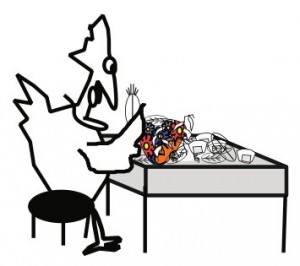by Patricia Foreman
[If you missed part 1 of this guest article by Patricia Foreman, you can view it here:
City Chickens Can Save BIG TIME Tax Payer Dollars! (Part 1).]
Here’s how it can work. The math is simple, so don’t be intimidated by it.
Step 1: Chicken Feed
A chicken eats its weight in food every month, approximately. So a standard size chicken eats about 6 to 8 pounds of feed per month. This is about 84 to 100 pounds of food per year. Some of this “chicken feed” can come from your kitchen and yard instead of a store-bought bag. And nearly 100% of these household food residuals can be kept out of the trash pickup and landfill. To save you from reaching for your calculator, here’s the math:
(1 chicken) x (7 pounds food residuals/month) x (12 months) = about 84 pounds.
“Big deal” you think. “That’s not so much.” But not so fast!
Step 2: Many Family Flocks
What if a city had 2,000 households, each having a flock of 6 (or more) chickens?
Here’s the math:
(6 chickens) x (84 pounds/year) x (2,000 households) = 504 tons/year
That’s 504 tons per year kept out of the trash pick-up stream!
Step 3: Tipping Fee Expense
The next step is to find out what the local tipping fees are at your landfill. A tipping fee is the cost, usually per ton, to dump trash. A landfill tipping fee is usually charged to pay for the cost of opening, maintaining, and eventually closing the landfill site.
In the Northeastern U.S., the average tipping fee in 2004 was $70/ton. So for our example, multiply the tipping fee ($70/ton) times (504 tons diverted by chickens) = $35,280 tax dollars saved just from tipping fees!
Step 4: Waste Removal Fees
Now estimate the “waste removal charges” to get total cost savings of trash NOT picked up and transported by your local solid waste management system.
In my hometown (in 2009), it cost about $106 per ton of trash for the city to pick it up, transport it, transfer it, and dump it into the land fill. Knowing the average cost per ton of trash for waste removal charges, and using our estimate from Step 2 that 2,000 families keeping flocks of 6 chickens can bio-recycle about 504 tons each year, we can estimate the total savings to the city in waste removal fees by multiplying:
(504 tons bio-recycled by chickens) x ($106 cost/ton for solid waste or trash, not picked up) = $53,424 potential city savings.
Step 5: Total Savings
The last calculation is to add the tipping fee and solid waste management costs, and you get a savings total of about:
- Tipping fee savings: $35,280/year
- Trash collection savings: $54,424/year
- Total: $88,704/year estimated taxpayer savings.
So, in this rough example, just by allowing folks to keep family flocks to bio-recycle biomass, the city could save about $89 thousand dollars.
Keeping chickens is not for everyone, and it shouldn’t be. A general rule of thumb is that about 5% of a households might be interested in keeping a family flock. In this example, I admit these numbers are soft, and the variables are quite “variable”. But in truth, regardless what the actual numbers might be, there is a genuine savings to tax payers and the environment.
So folks, here’s the bottom line. Just by changing a few lines of city code to allow and even encourage residents to keep family flocks — significant amounts of biomass “waste” could be diverted from the trash collection stream and kept out of landfills.
And if this were not enough, consider that the biomass NOT going to landfills won’t create the global warming gas methane.
The ramifications are HUGE!
Many cities in Europe are using this strategy effectively. One example is the city of Diest in Flanders, Belgium. They officially use chickens to reduce their trash management budget. Diest bought laying hens and gave them to 2,000 households. That’s right, they had a line item expense in their budget to purchase chickens to give to residents. City officials are employing chickens as an economical solution to their costly problem of trash management.
In other words, The City of Diest is saving significant amounts of their trash management expense by using backyard poultry power to keep “trash” out of the trash. From the city manager’s point of view, the chickens’ production of eggs, compost (topsoil), and fertilizer are simply spin-off benefits to the residents. These benefits are to you, your yard, your garden, your community, and our environment. Chickens are truly pets with benefits.
Is there actual data on clucking civic workers and biomass recycling? Not in the U.S. yet. But we have the protocol worked out to gather data and estimate tax-payer cost savings. We even have chicken keeping and composting classes ready to go. I personally, would love to collaborate with city officials to further research and quantify the “Chickens as Civic Solid Waste Management Employees” solution. Not only to ease strapped city budgets, but to also help save the environment. Perhaps some grant money can come forth for such projects.
There is more detail about employing clucking civic chicken workers in my book: City Chicks: Keeping Micro-flocks of Chickens as Garden Helpers, Compost Creators, Bio-recyclers and Local Food Suppliers.
May the flock be with YOU!
Patricia Foreman
[scg_html_patforeman_signature]




Don’t know what to say to Tera but my girls eat just about everything except the weeds I’d love for them to eat. Cabbage leaves and broccoli are their favorite, that’s when they can’t get fresh tomatoes and bugs. Just found out tonight that they will eat just about anything that I put in my compost pile, including a cheese cake I didn’t like….but they sure did! As a point of fact, I have found that if it goes in the green recycle bin or compost pile…they will eat it. That is a lot of junk not going into the landfill. Then you take all that wonderful chicken poo and compost it with whatever the hens didn’t eat; add that to your garden (best fertilizer you can get) and grow your own veggies! Self sustainable ag isn’t just about being green, it’s also about being self sufficient!
That’s really cool but my chickens are very picky eaters. Since they were chicks I have offered them scraps because I hoped to have these little green disposals but they only like bananas and oats. They didn’t like cabbage, carrot or even spaghetti noodles. They don’t eat greens I toss out, nothing really. They will clean up after I have watermelon…sometimes.
Wow……… that just floors me! Someone should make a stand to that because that is incredible. They need to make this a necessity. Why not free eggs for their waste of food.
A couple of comments on “soft” figures…
In our cities (central California), *we* pay for trash removal, not the city. Although that reduces the taxpayer benefit, it does directly help the individual homeowners.
2000 household at 5% indicates 40,000 households in the area. That’s a reasonably large community, but not impossible in large suburban sprawl areas like ours.
Now, just convince the city councils!
Let’s not forget a Green Alarm Clock!
Excellent post, Pat!
Alarm clocks only come with the roosters which are not necessary for eggs!